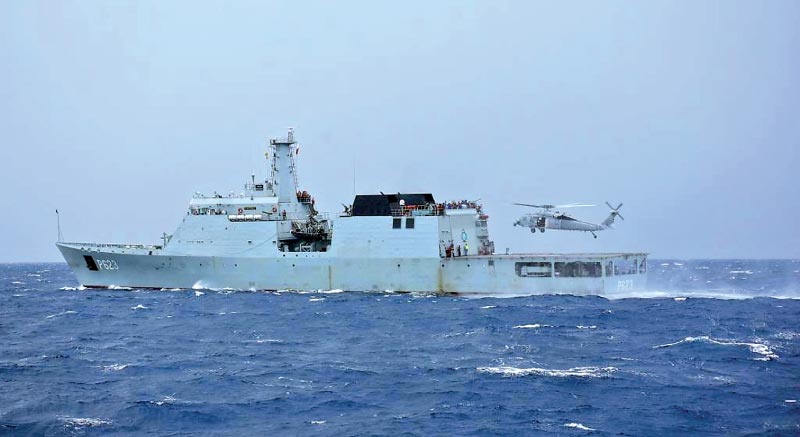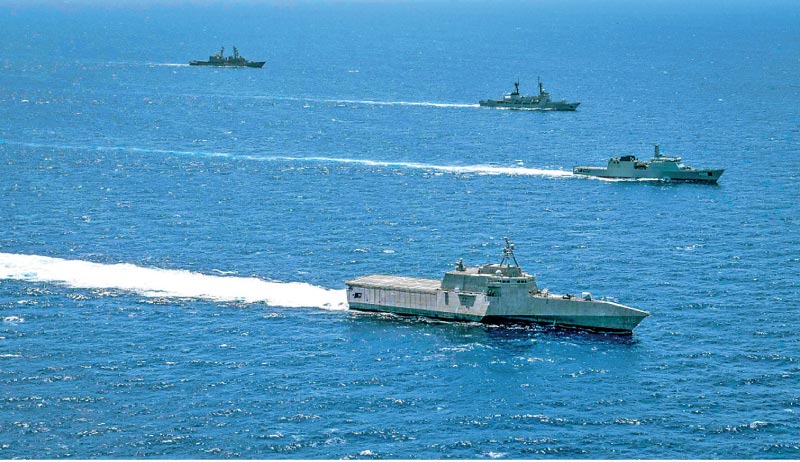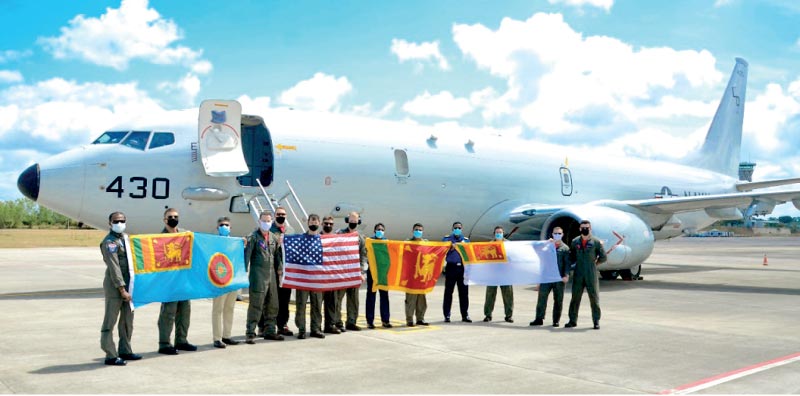Tuesday Jan 20, 2026
Tuesday Jan 20, 2026
Thursday, 15 July 2021 00:05 - - {{hitsCtrl.values.hits}}

A USN HM-60S helicopter from USS Charleston lands on Sri Lanka Navy vessel SLNS Sayurala (P623) during the Cooperation Afloat Readiness and Training (CARAT) 2021 exercise – Pic courtesy SLN
By Asiri Fernando
|
USN Commanding Officer of the US Navy warship USS Charleston (LCS 18) Cmdr. Joseph Burgon
|
Sri Lanka’s maritime trade hub ambitions and future economic success depend on sound economic strategies and a robust foreign policy as well as on her ability to work in partnership with regional and global actors to ensure the safe navigation and security of the maritime domain around the Island.
Many of the undersea communications cables, critical to the digital connectivity and global trade routes which carry most of the world’s seaborne trade, traverse through Sri Lanka’s maritime domain in the Indian Ocean. Countries that border the Indian Ocean Region are also home to one-third of the world’s population and have many endangered marine ecosystems.
With natural disasters and man-made disruptions on the rise and given the large expanse of the Indian Ocean Region, no one country can afford to ‘go alone’ in responding to maritime challenges, as made evident to Sri Lanka by the recent marine environmental disaster brought on by MV X-Press Pearl and MT New Diamond tanker fire incidents of 2020 and the 2004 tsunami.
Exercise CARAT 2021 ends successfully
A six-day joint maritime exercise between the US, Japanese and Sri Lankan forces held in the vicinity of the strategic deep-water port of Trincomalee came to an end on 30 June.
Exercise Cooperation Afloat Readiness and Training (CARAT) 21, the third iteration, organised annually by the US Navy 7th Fleet, saw the Japanese Maritime Self Defence Force (JMSDF) join its Sri Lankan and American counterparts for the first time.
Sri Lankan Navy (SLN) vessels the SLNS Sayurala (P623) and SLNS Gajabahu (P626), engaged with the US Navy’s warship, USS Charleston (LCS-18), and its embarked helicopter (a MH-60S). Joining the exercise with the US and Sri Lanka for the first time were the Japanese Maritime Self-Defence Force (JMSDF) destroyer, the JDS Yugiri (DD 153), and its embarked MH-60R helicopter. A US Navy P-8A Poseidon Maritime Patrol Aircraft, SLAF aircraft from the No. 03 Maritime Squadron and helicopters from the No. 07 and No. 04 Squadrons also joined the exercise.
In another first, CARAT-21 was also supported by the United Nations Office of Drugs and Crime (UNODC) and the EU Critical Maritime Route Wider Indian Ocean (CRIMARIO).
“The naval exercise saw a variety of joint training opportunities, including Humanitarian Assistance and Disaster Relief (HADR), Maritime Domain Awareness (MDA), Maritime Aviation, Replenishment at Sea (RAS), Surface TRACKEX, Visit Board Search and Seizure (VBSS), Search and Rescue (SAREX) and a wide range of naval exercises which were conducted adhering to COVID-19 protocols" the SLN said in a statement.
A B200 reconnaissance aircraft from the No. 03 Squadron, SLAF and a USN P-8A Poseidon aircraft flew multiple sorties, including one during a simulated mission to track an 'unidentified vessel of interest,' a role played by one of the Iranian dhows (traditional Arabian fishing vessel) that SLN intercepted trafficking narcotics some years back. According to the SLN, Air Force helicopters carried out several deck landings on SLNS Sayurala while she was underway and conducted vertical replenishment drills. The US Navy SH-60R helicopter from the USS Charleston also carried out a cross-deck landing exercise, landing on SLNS Sayurala.
Interview with Cmdr. Joseph Burgon
The six-day air-naval exercise enabled the participating countries to plan, simulate and practice coordinating complex multi-domain operations using a range of technologies, thereby improving cooperation, communication and interoperability between them, Cmdr. Joseph Burgon, Commanding Officer of the US Navy warship USS Charleston (LCS 18) told the Daily FT in an exclusive interview.
Cmdr. Joseph Burgon graduated with distinction from the United States Naval Academy in 2004 with a Bachelor of Science degree in Political Science. During his senior year at the Naval Academy, he was selected for the Voluntary Graduate Education Program, earning a Master of Arts degree in Government and Politics from the University of Maryland, College Park. He has also completed the Naval Postgraduate School’s Executive Master of Business Administration Program.
Cmdr. Burgon has served aboard the vessels USS Chaffee (DDG 90), USS Port Royal (CG 73), USS Lake Erie (CG 70) commanded the USS Champion (MCM 4) and USS Cowpens (CG 63).He has been awarded the Meritorious Service Medal, Navy and Marine Corps Commendation Medal (5 awards), the Navy and Marine Corps Achievement Medal, and various unit and campaign awards.
Following are excerpts of the interview:
 Q: What are your views on exercise CARAT 2021 as a whole?
Q: What are your views on exercise CARAT 2021 as a whole?
Together our three countries had a great exchange in communicating and proved that we can operate successfully and proficiently by doing some complicated manoeuvres including coordinating four different aircraft from three countries, with four ships working in close proximity. I think it shows how well we communicate with each other and how well the early planning and dialogue paid off in performing complex tasks.
Q: Given your interaction with the Sri Lanka Navy and Air Force during Ex. CARAT 21, what are your impressions of them?
I am very impressed with the amount of planning and cooperation extended for the exercise. I can tell you that for this one (Ex. CARAT 2021) we had good cooperation from all levels of the chain of command. The professionalism shown by the Sri Lankan armed forces was top notch. I very much enjoyed working with them.
Q: Due to health regulations relating to the COVID-19 pandemic, most of the interaction was virtual. How did this affect the exercise?
It was certainly a challenge. A lot of the CARAT exercise is based upon the interactions and exchanges between different participants involved. But I think the key to overcoming the limitations was early planning and coordination throughout all levels of command which ensured that once we got to Port everything was already set up for us to have the high-quality interaction virtually. Whilst COVID did limit physical interaction, I don't think it diminished the quality of the exercise.
Q: What type of activities did exercise CARAT 2021 involve?
We did the helicopter interoperability drills which are vertical replenishment and deck-landing qualifications. We also did a lot of formation steaming (navigating information and close proximity) including positioning tactics where ships would be called into manoeuvre as close as 500 yards between vessels, which showed some great seamanship qualities from all three countries. We also conducted some tracking exercises for a surface target of interest; working with our naval and aviation assets to track such targets.
Q: What type of interoperability will help the US and Sri Lanka work more effectively in this region?
I can't comment on the future. What I can tell you is that we demonstrated a great deal of interoperability, underway during CARAT 2021. That includes having cross-deck helicopter opportunities, subject matter experts worked together on tasks like underway replenishment and Visit Board Search and Seizure (VBSS). There were a lot of things we were doing during this exercise to work on interoperability.
With all the planning and communication that went into it, we were able to achieve a number of high-level objectives. I can say that CARAT 2021 took the exercise CARAT engagement with Sri Lanka to the next level.
Q: Japan joined CARAT 2021 with the US and Sri Lanka for the first time. Do you think that Japan joining in will improve the partnering capability of the three countries?
Yes, Japan joining the exercise this year definitely added an additional layer of complexity. And it did do as anticipated, which was to enhance cooperation between all three professional partners to protect the territorial and maritime sovereignty in line with international rules and norms.
Q: CARAT 2021 saw the participation of the United Nations Office of Drug and Crime (UNODC) and the EU Critical Maritime Route Wider Indian Ocean (EU CRIMARIO). What are your views on the maritime law enforcement aspect that was included for the first time?
I think it is fantastic that the EU and UN continue to invest in the maritime security of the Indo-Pacific. EU CRIMARIO is a program that provided capacity building in the western Indian Ocean Region for a number of years, and it now focuses on Southeast and South Asia. We got experience from them regarding the best ways to share information, especially during a crisis, and I think that at this exercise we achieved that objective.
Q: During the exercise, you had the opportunity to work alongside SLNS Gajabahu, an ex. US Coast Guard cutter. What are your views regarding building interoperability with the ex USCG vessel now in Sri Lankan service?
I can say that by watching them operate that ship, they were very proficient and very professional. In terms of interoperability, we worked well with the Gajabahu as well as the Sayurala throughout the entire exercise. I have to hand it to my Sri Lankan counterparts; they are among some of the most professional mariners I have met.

Steaming ahead in formation, USS Charleston (LCS-18), bottom, accompanied by SLNS SLNS Sayurala (P-623), upper right, SLNS Gajabahu (P-626), right, and the JMSDFs JS Yuugiri (DD-153), left, during an exercise for CARAT 2021 – Pic courtesy USN MCS PO 3rd Class Adam Butler

US Navy P-8A with SLN and SLAF observers during CARAT 2021
“These engagements help build confidence”: Sri Lanka Navy Rear Admiral Y.N. JayarathnaSri Lanka Navy Deputy Chief of Staff and Commander Eastern Naval Area, Rear Admiral Y.N. Jayarathna told Daily FT that Sri Lanka stood to gain from exercises such as CARAT 2021, by being equal partners. |
A valuable learning experience and a rare opportunity: Sri Lanka Air ForceGroup Captain Sameera Gunawardane, CO No. 07 Squadron, who was the overall mission coordinator for the SLAF during the exercise, said that it provided a valuable learning experience for helicopter pilots operating in the maritime environment. |
“We spent a year planning CARAT 2021 exercise”: US Navy LT Lauren Chatmas“Our countries spend the entire year planning the CARAT Sri Lanka exercise, to be unique in their design. The planning cycle was immensely valuable for learning culturally, how we communicate and plan, and better see the expertise that everyone brings. By working together during periods of calm, our forces are better prepared to respond cooperatively to future real-world events in a timely and effective manner when called upon,” said US Navy LT Lauren Chatmas, Public Affairs Officer of Destroyer Squadron (DESRON) 7, Singapore, responding to a question on if the cooperation built through exercises such as CARAT 2021 would help Sri Lanka and the US better respond to Humanitarian Assistance and Disaster Response (HADR) style missions in the Indian Ocean region. |